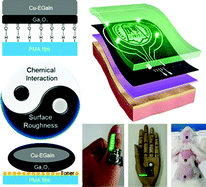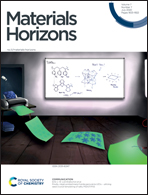Cu–EGaIn enabled stretchable e-skin for interactive electronics and CT assistant localization†
Abstract
Electronic skin (e-skin) is attracting huge attention due to its promising applications in diverse fields, including biomimetic machines, artificial intelligence and smart robotics. However, most e-skin circuits involve complicated fabrication processes and high costs. Here, a simple, fast fabrication method for highly conductive (6 × 106 S m−1) and stretchable (above 100%) e-skin based on the adhesion selectivity of a semi-liquid metal (Cu–EGaIn) on laser printed toner and a polymethacrylate (PMA) coating is developed. The stretchable e-skin circuits are shown to transfer to human skin and 3D substrates as wearable electronics for a variety of applications, such as temperature monitoring, interactive devices, and flexible displays. Different from other liquid metal patterning techniques that require expensive equipment or rigid metal traces such as silver nanoparticles, this approach can be used to directly print Cu–EGaIn on a stretchable substrate with a commercial laser printer in seconds. Further, by virtue of the advantage of the high radiological imaging capability of Cu–EGaIn, the e-skin is patterned as a computed tomography (CT) assistant localization marker, which is demonstrated to be very helpful for doctors and surgical robots to efficiently localize a biopsy, which is a core issue in clinics. The present study holds promise for future health care, surgical guidance and personalized entertainment.



 Please wait while we load your content...
Please wait while we load your content...